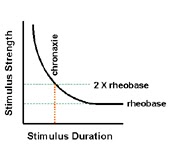It
shows the interdependence between stimulus strength and the time
required in activating the muscles. It indicates the strength of
impulses of various durations required to produce muscle contraction by
joining the points that graphically represent the threshold value along
the ordinate for various durations.
Advantages of SDC:
- This is a simple, reliable and shows a proportion of denervation.
Disadvantages of SDC:
- In large muscles it can not shows the full pictures but only a proportion of muscle fibers can be stimulated.
- It can not show the site of lesion.
Optimum timing of SDC:
SDC
test can be done 10 – 14 days after the lesion has occurred. The
degeneration of nerve from the proximal to distal is called Wallerian
degeneration. When the motor end plate is no longer functioning, it is
done weekly under the same condition until there is recovery and
decision has been reached on the eventual final state of the muscle. SDC
is used to identify denervation, partial innervation, and compression.
Methods of SDC:
Take a neuromuscular stimulator (TENS, DL2
stimulator) having rectangular duration i.e. 0.3, 0.1, 1, 3, 10, 30,
100, 300 ms and constant current. Put the passive electrode over the
midline of the body or near the origin of the muscle. Put the active
electrode over the fleshy belly of the muscle.
Alternately
both the electrodes are placed on both ends of the muscle. First apply
current having longest duration and look for minimum perceptible
contraction, gradually shorten the impulse duration and note the
corresponding increase in current strength. The electrode placement
should not be changed through out the test. Plot a SD graph from the
results of the test.
Characteristics of SDC:
i. Innervated muscles:
When
all the nerve fibers supplying the muscles are intact, the strength
duration curve has a shape characteristic of normally innervated muscles
as shown in the figure.
The
same strength of stimulus is required to produce a response with all
the impulses of longer duration, while those of shorter duration require
an increase in strengths of the stimulus each time the duration is
reduced.
ii. Denervated muscles:
When
all the nerve fibers supplying a muscle have degenerated, the strength
duration produced is characteristic of complete denervation as shown in
the figure.
For
all impulses with duration of 100 ms or less the strength of the
stimulus must be increased each time the duration is reduced and no
response is obtained to impulses of very short duration. The curve rises
steeply and is shifted to the right than that of normally innervated
muscle.
iii. Partial denervated muscles:
For
the stimulation of denervated fibers impulses of longer duration are
required while for the stimulation of innervated fibers impulses of
shorter duration are required. The kink produce show the partial
denervation which disappear after 10 -20 days or month.
· Rheobase (Rheo means intensity/ stimulus strength and base means foundation):
· Chronaxies (Chron means time and axie means axis):
The stimulus duration that produces a response when the stimulus strength is set to exactly at double rheobase.





good explaination
ReplyDeleteit was very helpful
imran khan is best
Thanks
ReplyDeleteThanks
ReplyDeleteGood article
ReplyDeleteGood article
ReplyDeletehttp://physiotherapylearn.blogspot.in/2018/02/how-to-reduce-low-back-pain-kamar-dard.html?m=1
ReplyDeletethanks sir ji
ReplyDelete